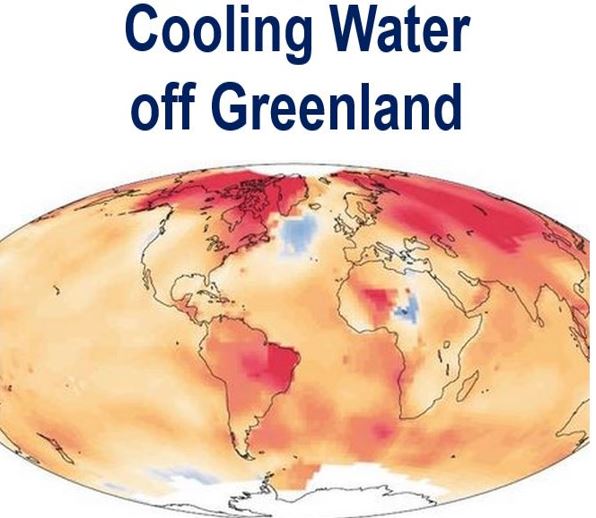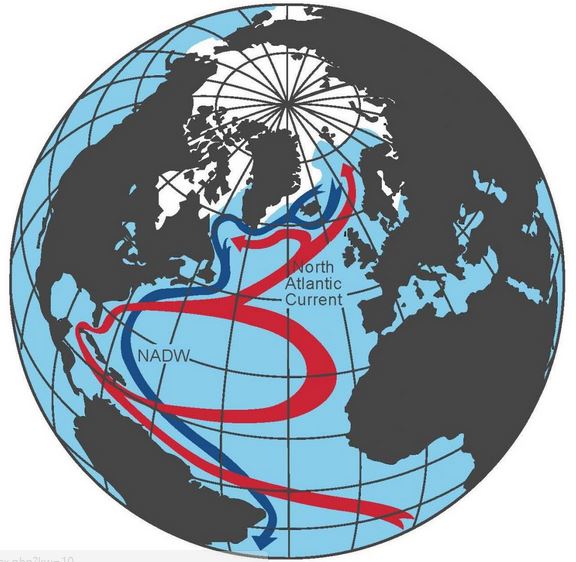The Gulf Stream, which prevents Britain from freezing over in winter, is slowing at its fastest rate in one thousand years. Does that mean the British Isles and some other northern European countries are facing lower and lower temperatures in future winters?
As climate change is bringing higher temperatures globally, it is more likely that this slowdown in what scientists call Atlantic Overturning will reduce the effects of global warming in north west Europe and parts of the United States.
The Atlantic Meridional Overturning Circulation (Atlantic Overturning) is a major current in the Atlantic Ocean. There is a northward flow of warm, salty water to the upper layers of the Ocean (the Gulf Stream), and a southward flow of colder water in the deep Atlantic. It is a major component of the Earth’s climate system.

Just below Greenland you can see a large blue area, that is where the water is cooling. (NASA GISS warming map 1901-2013)
Atlantic Overturning has slowed down by 15% to 20% over the past century. The slowdown has become more marked since 1970, a study led by the Potsdam Institute for Climate Impact Research informed.
The researchers’ findings have been published in the academic journal Nature Climate Change (citation below).
The gradual melting of the Greenland ice sheet, caused by human-induced global warming, is likely a major contributor to the slowdown, the authors wrote. They added that the ice-sheet’s melting is gathering pace.
European and American weather will probably be affected
They warn that marine ecosystems, sea levels, and weather systems in Europe and the United States will probably be affected if the Atlantic currents continue weakening.
Lead author, Stefan Rahmstorf, said:
“It is conspicuous that one specific area in the North Atlantic has been cooling in the past hundred years while the rest of the world heats up.”
Previous studied had already suggested that a slowdown of the Atlantic Meridional Overturning Circulation may be the culprit.
Mr. Rahmstorf added:
“Now we have detected strong evidence that the global conveyor has indeed been weakening in the past hundred years, particularly since 1970.”

This illustration shows the Atlantic Conveyor – a graph of the Atlantic Meridional Overturning Circulation. (Credit: Stefan Rahmstorf/PIK)
As long-term data on direct ocean current measurements were not available, the researchers relied on sea-surface and atmospheric temperature data to derive information about the Atlantic ocean’s currents, exploiting the fact that ocean currents are the main cause of temperature variations in the sub-polar north Atlantic.
From data gathered from lake and ocean sediments, tree rings, coral, and ice cores, temperatures can be reconstructed for more than one thousand years at a time.
The research team found that recent changes, since the year 900 AD, are ‘unprecedented’, and suggest that they are caused by human-induced global warming.
Greenland ice sheet melting probably disrupting circulation
The Atlantic overturning occurs because of differences in the density of the ocean’s water. Warm water from the south, which is lighter, flows northward, while cold and denser water sinks deeper and flows southward.
Jason Box, of the Geological Survey of Denmark and Greenland, said “Now freshwater coming off the melting Greenland ice sheet is likely disturbing the circulation.”
Greenland’s melting ice sheet has fresh water, as this pours into the sea it is diluting the ocean water. Less saline water is less dense and is therefore less likely to sink, even when it is cold.
“So the human-caused mass loss of the Greenland ice sheet appears to be slowing down the Atlantic overturning – and this effect might increase if temperatures are allowed to rise further,” explains Mr. Box.
Observations of the water just south of Greenland show it is cooling more rapidly than what most computer climate simulations have so far suggested.
Michael Mann, of Pennsylvania State University, said:
“Common climate models are underestimating the change we’re facing, either because the Atlantic overturning is too stable in the models or because they don’t properly account for Greenland ice sheet melt, or both.”
“That is another example where observations suggest that climate model predictions are in some respects still overly conservative when it comes to the pace at which certain aspects of climate change are proceeding.”
Not a new ice age – but bad things will happen
The Northern Atlantic will cool, but it will only slightly offset the effects of the continued warming of continents.
The research team definitely does not expect we are facing a new ice age. “Thus the imagery of the ten-year-old Hollywood blockbuster ‘The Day After Tomorrow’ is far from reality,” they wrote.
However, it is well known in science that a large, even gradual change in the circulation of waters in the Atlantic Ocean may have significantly negative effects.
Rahmstorf said:
“If the slowdown of the Atlantic overturning continues, the impacts might be substantial. Disturbing the circulation will likely have a negative effect on the ocean ecosystem, and thereby fisheries and the associated livelihoods of many people in coastal areas.”
“A slowdown also adds to the regional sea-level rise affecting cities like New York and Boston. Finally, temperature changes in that region can also influence weather systems on both sides of the Atlantic, in North America as well as Europe.”
If the circulation slows down too much it could collapse completely – the Atlantic overturning has long been considered by scientists as a possible tipping element in the Earth System.
If this happened, it would do so rapidly and we wouldn’t be able to do anything to reverse it.
The Intergovernmental Panel on Climate Change (IPCC) estimates that there is up to a 10% chance that this might happen in this century.
Expert surveys suggest many scientists believe the risk is much higher.
Citation: “Evidence for an exceptional 20th-Century slowdown in Atlantic Ocean overturning,” Rahmstorf, S., Box, J., Feulner, G., Mann, M., Robinson, A., Rutherford, S. and Schaffernicht, E. Nature Climate Change. Published 23 March, 2015. DOI: 10.1038/nclimate2554.
NASA Video – The Great Ocean Conveyor Belt
This NASA animation first depicts thermohaline surface flows over surface density, and shows how water sinks in the dense ocean near Iceland and Greenland. The surface of the ocean then fades away and the animation pulls back to show the global thermohaline circulation.
